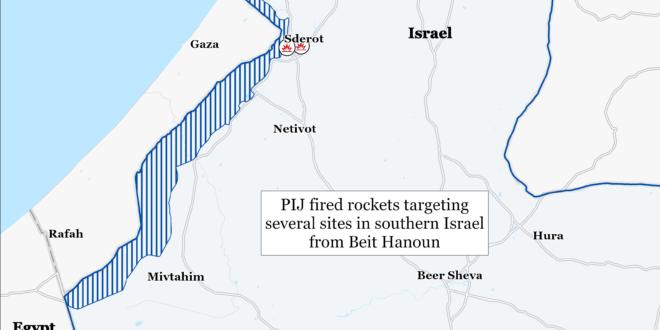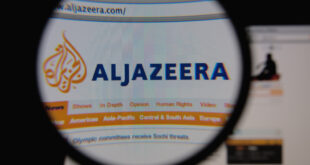Acting Iranian Foreign Minister Ali Bagheri Kani defended Iran’s impending retaliatory strike against Israel while signaling that Iran seeks to avoid a regional war during an Organization of Islamic Cooperation meeting in Jeddah, Saudi Arabia, on August 7.[i] Bagheri Kani argued that Iran “has no choice” but to exercise its right to self-defense and restore deterrence against Israel. This is consistent with CTP-ISW’s assessment that Iran is likely planning a retaliatory attack on Israel to restore deterrence after the failed Iranian April 2024 attack while Iran simultaneously tries to avoid a large-scale war with Israel.[ii] Iran and its allies fired around 170 one-way attack drones, 30 cruise missiles, and 120 ballistic missiles at Israel in the April 2024 attack.[iii] The United States, Israel, and their allies intercepted most of the projectiles, and the Iranian attack did significantly less damage than Tehran intended.[iv] Iranian leaders likely calculate that they failed to deter Israel with their April 2024 attack because they did not inflict serious damage.
Iranian armed forces-run media is continuing to publish information that likely aims to decrease Israel’s ability to effectively defend against an Iranian attack by causing Israel to disperse its air- and missile-defense assets. Iranian armed force-run outlet Defa Press argued on August 7 that Iran and the Axis of Resistance should target Israel from multiple directions to disperse Israeli assets, thereby exposing targets.[v] Defa Press claimed that Iran and its Axis of Resistance could increase the volume of munitions targeting specific targets, particularly “sensitive military bases,” to exploit such vulnerabilities. Iran may or may not try to attack any of these targets or others. CTP-ISW assessed on August 4 that Iran and its Axis of Resistance will most likely conduct a coordinated, large-scale drone and missile attack on Israel in response to Israel killing Hamas Political Bureau Chairman Ismail Haniyeh in Tehran.[vi] Iran’s suggestion that it should target Israel from multiple directions does not, however, validate this August 4 assessment because publicizing relatively specific information like this is likely intended to generate informational effects. The August 7 report is a continuation of previous Iranian reporting covering how Iran will conduct its retaliatory strike. Defa Press published a list of potential Israeli civilian and military targets spread throughout Israel on August 5 which CTP-ISW suggested was likely also meant to cause Israeli Defense Forces (IDF) to disperse air- and missile-defense assets across a wide area.[vii] This ongoing information effort probably intends to increase the likelihood that Iran can hit some of its targets, but it is not clear that this effort will be successful. The US-Israeli coalition intercepted most Iranian drones and missiles outside of Israel during the April 13, 2024 attack on Israel.[viii]
The Islamic Resistance in Iraq—a coalition of Iranian-backed Iraqi militias—is expected to conduct “continuous” strikes on US forces in Iraq and Syria “in the coming period” according to an unspecified leader in Harakat Hezbollah al Nujaba cited by Lebanese news outlet al Akhbar on August 7.[ix] The new attack campaign is reportedly in retaliation for Israel’s killing of Haniyeh and senior Hezbollah commander Fuad Shukr and to continue Iranian-backed Iraqi militia efforts to expel US forces from Iraq and Syria, according to unspecified sources affiliated with the Islamic Resistance in Iraq. The Islamic Resistance in Iraq’s attack campaign targeting US forces in Iraq and Syria supports Iranian efforts to conduct a retaliatory strike on Israel by attempting to draw US attention and resources away from supporting Israel’s defense. The United States, Israel, and partners in the region collectively intercepted approximately 99% of all munitions launched by Iran during its April 2024 attack.[x]
Unspecified Arab sources cited by the Jerusalem Post on August 6 reported that Pakistan plans to provide Iran with Shaheen-III medium-range ballistic missiles if conflict between Iran and Israel escalates.[xi] The Pakistani Minister of Information and Broadcasting rejected the claim.[xii]
The Axis of Resistance and Iran are coalescing around Yahya Sinwar as Hamas’ new leader. Hamas selected Sinwar, who helped mastermind the October 7 attacks, “by consensus” after “extensive deliberations.”[xiii] Major Palestinian factions issued statements supporting Sinwar’s selection as Hamas’ next Political Bureau leader. Fatah, Palestinian Islamic Jihad, the Popular Front for the Liberation of Palestine, the Palestinian Resistance Committees, and several other groups praised the speed and unity of Sinwar’s selection.[xiv] Lebanese Hezbollah praised Sinwar’s ”unanimous election” and called his selection a “strong message” to Israel and the United States about Hamas‘ unity and its determination to continue ”resistance and jihad.” [xv] Iranian Armed Forces Chief Mohammad Bagheri also praised Sinwar’s selection, adding that it brings ”hope, joy and happiness.”[xvi]
Sinwar’s leadership is very unlikely to change Hamas’ maximalist position on ceasefire and hostage negotiations in the Gaza Strip. Sinwar exercised significant influence within Hamas after October 7 given his command of Hamas’ forces and control of hostages on the ground. Sinwar’s control of the hostages and his command over military forces on the ground as the top Hamas political leader in the Gaza Strip meant that his practical influence outstripped that of Haniyeh, because Sinwar could simply refuse to release the hostages or cease military operations. Sinwar has also retained Khalil al Hayya as lead negotiator in ceasefire talks after assuming leadership of Hamas.[xvii] Hayya has been Sinwar’s deputy in the Gaza Strip since 2017, meaning that the two presumably have a close working relationship.[xviii] Israeli sources have suggested that ceasefire talks are on an indefinite hold and will not resume before Iran retaliates against Israel for Haniyeh’s death.[xix] US President Biden told Arab mediators that it is urgent to reach a ceasefire “as soon as possible” and that talks have reached a ”final stage.”[xx]
The death of a Houthi drone expert responsible for training Iranian-backed Iraqi militias in the July 30 US strike in Iraq indicates a possible Iranian-backed effort to improve the targeting capabilities of the Iranian-backed Iraqi militias against both US forces and Israel.[xxi] The United States conducted a self-defense strike that killed a senior Houthi commander and drone expert at Kataib Hezbollah’s Jurf al Sakhr facility in Iraq on July 30.[xxii] The Houthis confirmed that the strike killed the commander, who had traveled to Iraq to train other Iranian-backed Iraqi militias in drone tactics.[xxiii] An Iraqi journalist also reported that four other Houthi fighters died in the strike and that all five Houthis were buried in Wadi al Salam in Najaf, Iraq.[xxiv] The Houthis have years of experience conducting successful drone attacks targeting facilities in Saudi Arabia and the United Arab Emirates that are protected by US air defense systems, such as the Patriot and THAAD.[xxv] The Houthis more recently have proven that their drones can evade Israeli air defense systems, at least in isolated incidents.[xxvi] This is notable given the relative lack of success Iraqi-backed militias have had in targeting US positions in the region. Houthi instruction may therefore be aimed at improving the success of Iranian-backed Iraqi militia attacks against both the United States and Israel.
The Houthi decision to deploy this commander to Iraq to train Iraqi militias suggests that Iran and the Houthis seek to rapidly accelerate the training of these militias. Iran and the Houthis could have presumably decided to send small numbers of Iraqi militia members to Yemen for training as part of a “train-the-trainer”-style program. The drone expert’s presence in Iraq, however, would have enabled him to train much larger numbers of Iraqi militia members much more rapidly, allowing the knowledge to be disseminated directly without an intermediary trainer. The Iraqi journalist also reported that the Houthis were coordinating with Kataib Hezbollah, Harakat Hezbollah al Nujaba, Ansarallah al Awfiya, and other Iranian-backed militias, which would be consistent with an effort to train larger numbers of fighters and Iraqi militias more efficiently.[xxvii]
Russian officials are continuing coordination with Iran ahead of the Iranian retaliatory strike against Israel out of concern for Russian interests in the region. Reuters reported that Russian President Vladimir Putin delivered a message via Russian Security Council Secretary Sergei Shoigu that Iran should act with restraint and avoiding targeting civilians when retaliating against Israel.[xxviii] An unspecified Iranian diplomat claimed to IranWire that Russia is opposed to Iranian strikes that could lead to the death of civilians due to the large number of Russian citizens who live in Israel. The report did not make clear how an Iranian official would understand the calculus behind the Russian decision making.[xxix]
Russia is also reportedly assisting Iranian efforts to improve its air defenses against Israeli attacks, according to the New York Times.[xxx] The New York Times, citing two unspecified Iranian officials including an IRGC member, stated that Russia began delivering advanced radars and air-defense systems to Iran.[xxxi] Iranian media has previously reported that Iran sought to acquire Russian air defense systems to improve Iran’s air defense network and defend against Israeli attack, according to the New York Times.
The US Office of the Director of National Intelligence (ODNI) highlighted a “notable increase” in Iranian statements on Iran’s ability to product a nuclear weapon, corroborating previous CTP-ISW reporting. ODNI published the 2024 annual report in compliance with the “Nuclear Weapons Capability and Terrorism Monitoring Act of 2022” on July 23.[xxxii] The ODNI assessed that ”Iran probably will consider installing more centrifuges” and increasing its enriched uranium stockpile ”up to 90 percent in response to additional sanctions, attacks, or censure against its nuclear program.”[xxxiii] The ODNI also emphasized a ”notable increase” of Iranian officials’ statements on Iran’s nuclear activities, including their ability to produce a nuclear weapon. This corroborates previous CTP-ISW reporting since May, which has noted that senior Iranian officials have normalized public discussions about Iran’s ability to procure a nuclear weapon.[xxxiv]
Qatari-owned, London-based al Araby al Jadeed reported on August 6 that Jordan expressed concern to Iraq about Iranian-backed Iraqi militias’ presence along the Jordan-Iraq border, citing two Iraqi officials.[xxxv] An unspecified Iraqi Parliament member and Iranian Foreign Ministry official said that Jordan raised concerns to Iraq over the presence of armed Popular Mobilization Forces (PMF) fighters along Jordan’s eastern border with Iraq’s Anbar Province. The PMF—an umbrella security organization consisting of many Iranian-backed Iraqi militias—ostensibly reports to the Iraqi prime minister but most of its constituent elements answer to Iran.[xxxvi] A prominent Iranian-backed Iraqi militia within the PMF threatened to create and arm a new 12,000-man Iranian proxy in Jordan on April 1, which CTP-ISW assessed may reflect a greater, more confrontational shift in the Iranian strategy vis-a-vis Jordan. The Iraqi officials also told al Araby al Jadeed that Jordan was worried that Iranian-backed Iraqi militias would “exploit” the PMF’s border deployments to conduct attacks against Israel through Jordanian airspace. Jordan recently indicated that it may shoot down projectiles that enter Jordanian airspace should Iran and the Axis of Resistance launch another attack on Israel.[xxxvii] Jordan shot down Iranian systems that Iran fired at Israel on April 13.[xxxviii] Jordanian Foreign Minister Ayman Safadi said that Jordan ”will not become a battlefield,” however.[xxxix] Jordan’s participation in the April 13 effort to shoot down Iranian drones targeting Israel drew criticism and condemnation from Iran, Palestinian militias, and Iranian-backed proxy groups.[xl]
Key Takeaways:
- Iranian Retaliation: Acting Iranian Foreign Minister Ali Bagheri Kani defended Iran’s impending retaliatory strike against Israel while signaling that Iran seeks to avoid a regional war during an Organization of Islamic Cooperation meeting in Jeddah, Saudi Arabia, on August 7.
- Hamas Succession: The Axis of Resistance and Iran are coalescing around Yahya Sinwar as Hamas’ new leader. Sinwar’s leadership is very unlikely to change Hamas’ maximalist position on ceasefire and hostage negotiations in the Gaza Strip.
- Houthis in Iraq: The death of a Houthi drone expert responsible for training Iranian-backed Iraqi militias in the July 30 US strike in Iraq indicates a possible Iranian-backed effort to improve the targeting capabilities of the Iranian-backed Iraqi militias against both US forces and Israel. The Houthi decision to deploy this commander to Iraq to train Iraqi militias suggests that Iran and the Houthis seek to rapidly accelerate the training of these militias.
- Russia and Iran: Russian officials are continuing coordination with Iran ahead of the Iranian retaliatory strike against Israel out of concern for Russian interests in the region. Russia is also reportedly assisting Iranian efforts to improve its air defenses against Israeli attacks, according to the New York Times.
- Iranian Nuclear Program: The US Office of the Director of National Intelligence (ODNI) highlighted a “notable increase” in Iranian statements on Iran’s ability to product a nuclear weapon, corroborating previous CTP-ISW reporting. CTP-ISW has noted that senior Iranian officials have normalized public discussions about Iran’s ability to procure a nuclear weapon.
- Jordan: Qatari-owned, London-based al Araby al Jadeed reported on August 6 that Jordan expressed concern to Iraq about Iranian-backed Iraqi militias’ presence along the Jordan-Iraq border, citing two Iraqi officials. Jordan is reportedly particularly concerned about the possibility that Iranian-backed Iraqi militias will fire drones and missiles from areas close to the Jordanian border towards Israel.
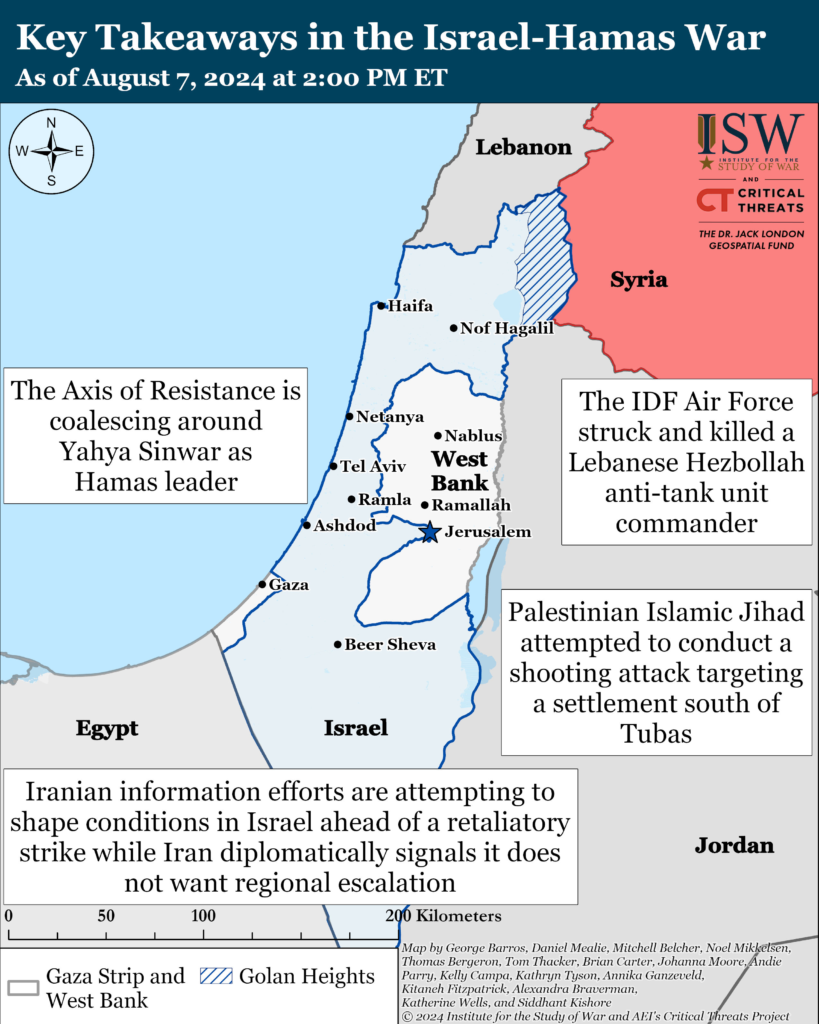
Gaza Strip
Axis of Resistance objectives:
Erode the will of the Israeli political establishment and public to sustain clearing operations in the Gaza Strip
Reestablish Hamas as the governing authority in the Gaza Strip
The Israel Defense Forces (IDF) issued evacuation orders for Beit Hanoun and surrounding areas of the northern Gaza Strip on August 6 and 7.[xli] The IDF said that it would operate “forcefully and immediately against” Hamas and other Palestinian militants who fired rockets from the area into Israel.[xlii] Palestinian Islamic Jihad (PIJ) launched three rockets targeting Ashkelon and Sderot on August 6 several hours before the IDF ordered the evacuation.[xliii] The IDF has conducted repeated low intensity clearing operations in Beit Hanoun since an initial clearing operation in Fall 2023 that rendered Hamas’ Beit Hanoun Battalion combat ineffective.[xliv] CTP-ISW assessed in March 2024 that a small number of Palestinian fighters had likely infiltrated Beit Hanoun.[xlv] The IDF has not conducted clearing operations in all of the recent evacuation zones it has identified, suggesting the evacuation orders are no longer a reliable indicator for imminent Israeli ground operations in a sector of the Gaza Strip.[xlvi]
The IDF 252nd Division continued clearing operations along the Netzarim Corridor, south of Gaza City on August 7.[xlvii] Israeli forces directed strikes on several Palestinian fighters in the corridor zone.[xlviii] A local Palestinian journalist reported that Israeli armor operated north of Nuseirat camp, Central Governorate.[xlix] Palestinian fighters mortared Israeli forces east of Bureij, Central Governorate.[l]
The IDF published the results of the 7th Brigade’s week-long clearing operation in eastern Khan Younis on August 7.[li] The 7th, 35th and 89th brigades withdrew from Khan Younis on July 30.[lii] The IDF 7th Brigade raided dozens of militia sites and killed over 70 Palestinian fighters in ground and air engagements.[liii] The 7th Brigade and the Yahalom combat engineering unit located, investigated and destroyed a 10-meter deep underground weapons workshop in Bani Suheila, east of Khan Younis.[liv] Israeli forces located several underground lathes in a Hamas weapons production workshop, along with tools, and weapons storage rooms.[lv] An Israeli military correspondent said in June that Hamas is continuing to manufacture weapons in Khan Younis as part of its effort to regenerate forces there.[lvi]
The IDF 162nd Division continued clearing operations in Rafah on August 7. Israeli forces engaged Palestinian fighters at close range and targeted several militia sites in Rafah.[lvii]
The IDF Air Force targeted dozens of militia sites across the Gaza Strip on August 7, including a building used by Palestinian fighters to target Israeli forces.[lviii] The IDF Air Force also struck a Hamas and PIJ weapons production site in Deir al Balah.[lix] The IDF noted that the site was inside the humanitarian zone, but added that the IDF Air Force took precautions to avoid civilian casualties.[lx] The IDF Air Force separately struck rocket launch sites in the southern Gaza Strip that Palestinian fighters had use to fire at least 18 rockets at Israel over the past week.[lxi] The IDF said that the launch site was located near two aid and distribution warehouses.[lxii]
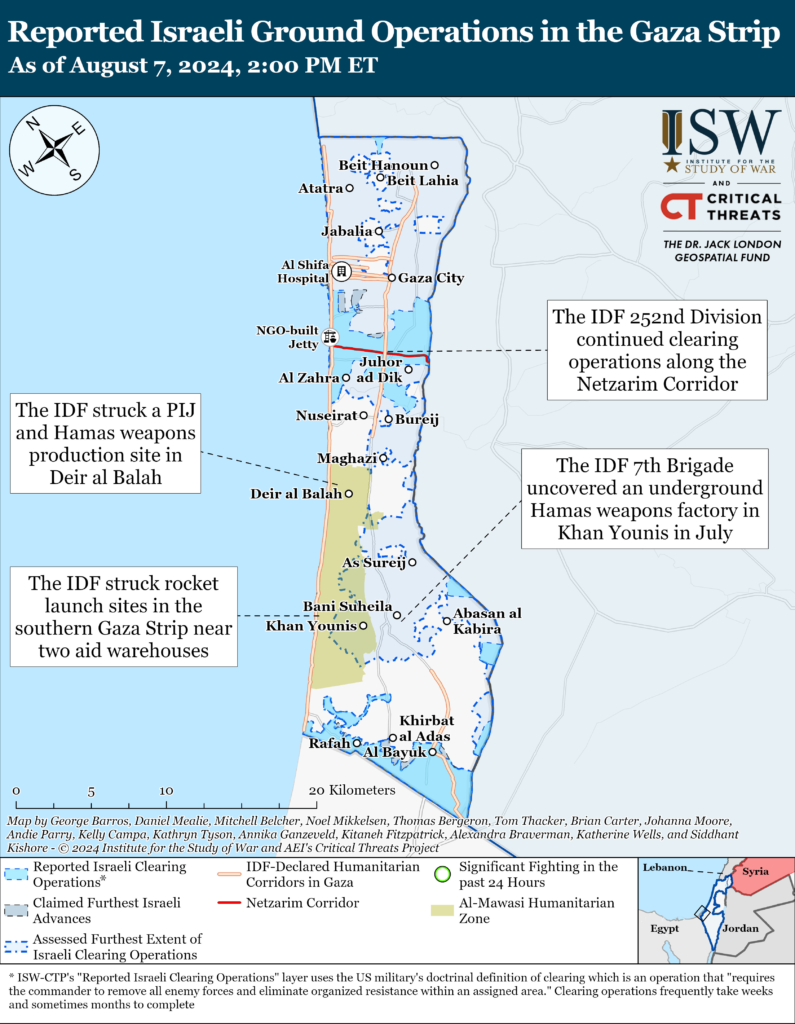
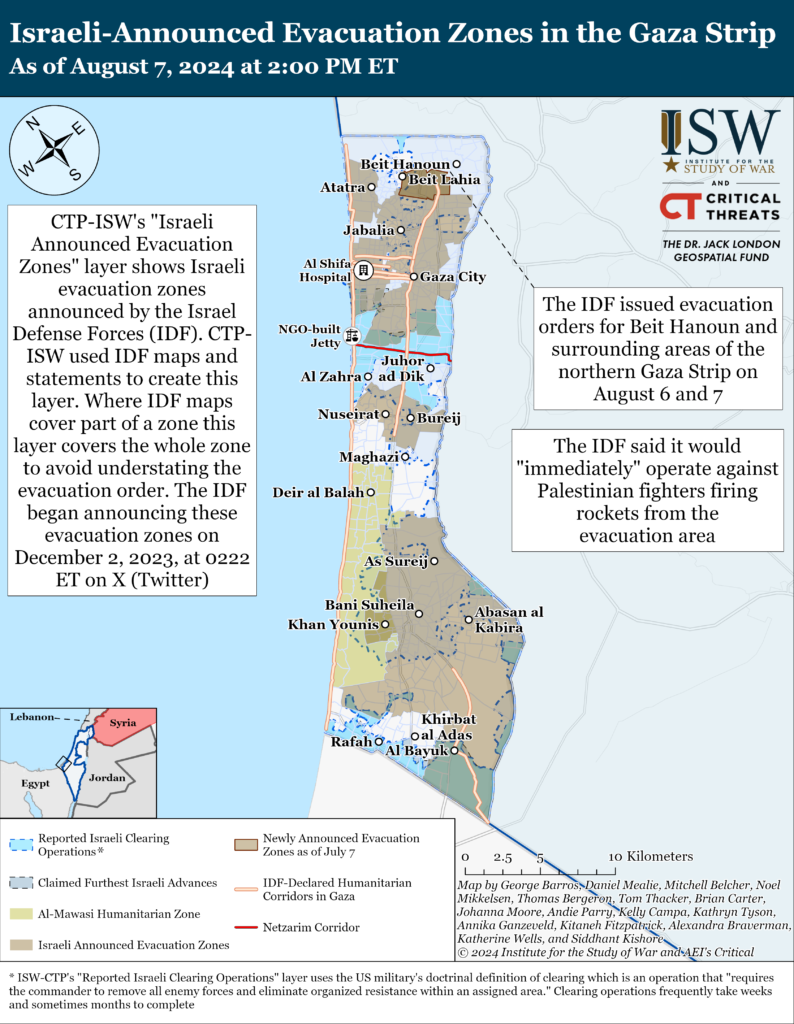
PIJ fired a barrage of rockets from the Gaza Strip targeting Ashkelon, Sderot, and Nir Am in southern Israel on August 6.[lxiii] The IDF said it detected three rocket launches from the northern Gaza Strip.[lxiv] The IDF intercepted one of the rockets and the other two fell in open areas.[lxv]
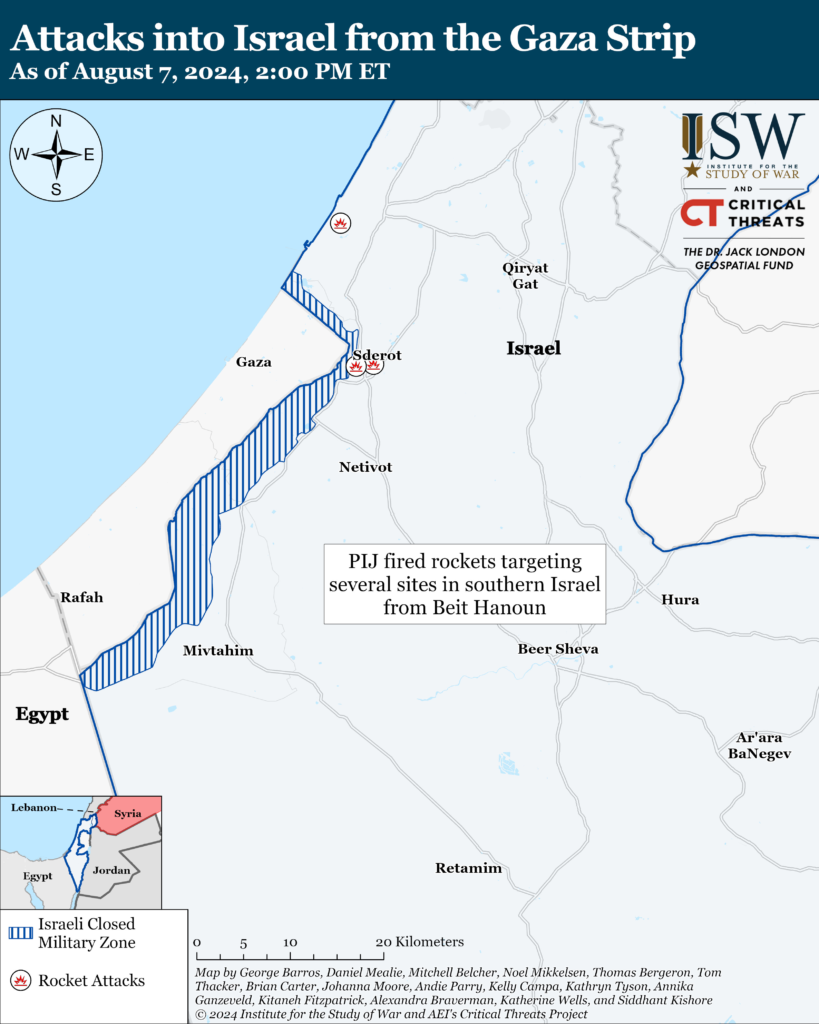
Recorded reports of attacks; CTP-ISW cannot independently verify impact.
West Bank
Axis of Resistance objectives:
Establish the West Bank as a viable front against Israel
Israeli forces have engaged Palestinian fighters in at least five locations in the West Bank since CTP-ISW’s last data cut-off on August 6.[lxvi]
Palestinian Islamic Jihad attempted to conduct a shooting attack near Beka’ot settlement, south of Tubas, on August 7.[lxvii] The IDF 636th Combat Intelligence Collection Unit killed the gunman.[lxviii] An Israeli military correspondent reported that the IDF had been on alert near Beka’ot following a previous shooting attack that targeted Beka’ot on August 5.[lxix] PIJ claimed the attack attempt and said that Tubas Battalion commander Rabie al Anbousi was killed while ”leading” the attack.”[lxx]
The IDF, Shin Bet, and Border Police identified and demolished an explosives laboratory storing ready-made improvised explosive devices (IED) in Balata refugee camp, Nablus, on August 7.[lxxi] Israeli forces raided Balata refugee camp and detonated the identified IEDs before demolishing the laboratory.[lxxii] The IEDs appeared to be relatively unsophisticated devices built from fuel canisters. The IDF said that Israeli forces fired at Palestinians who threw explosives and fired small arms at the IDF during its operation in Nablus.[lxxiii] The al Aqsa Martyrs’ Brigades targeted Israeli forces with small arms and detonated IEDs in several areas of Nablus, including in the Old City and Balata refugee camp.[lxxiv]
Israeli forces also confiscated two weapons-manufacturing lathes and detained three wanted Palestinians in al Eizariya, outside of Jerusalem.[lxxv]
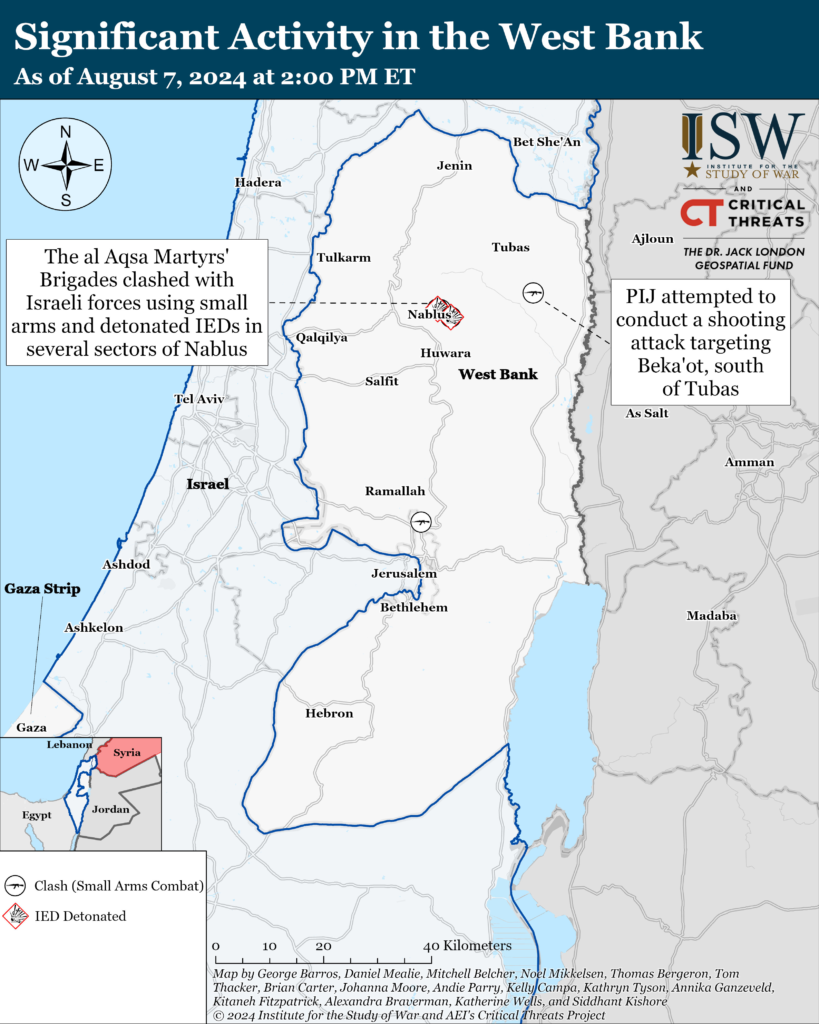
Recorded reports of attacks; CTP-ISW cannot independently verify impact.
West Bank
Axis of Resistance objectives:
Establish the West Bank as a viable front against Israel
Israeli forces have engaged Palestinian fighters in at least five locations in the West Bank since CTP-ISW’s last data cut-off on August 6.[lxvi]
Palestinian Islamic Jihad attempted to conduct a shooting attack near Beka’ot settlement, south of Tubas, on August 7.[lxvii] The IDF 636th Combat Intelligence Collection Unit killed the gunman.[lxviii] An Israeli military correspondent reported that the IDF had been on alert near Beka’ot following a previous shooting attack that targeted Beka’ot on August 5.[lxix] PIJ claimed the attack attempt and said that Tubas Battalion commander Rabie al Anbousi was killed while ”leading” the attack.”[lxx]
The IDF, Shin Bet, and Border Police identified and demolished an explosives laboratory storing ready-made improvised explosive devices (IED) in Balata refugee camp, Nablus, on August 7.[lxxi] Israeli forces raided Balata refugee camp and detonated the identified IEDs before demolishing the laboratory.[lxxii] The IEDs appeared to be relatively unsophisticated devices built from fuel canisters. The IDF said that Israeli forces fired at Palestinians who threw explosives and fired small arms at the IDF during its operation in Nablus.[lxxiii] The al Aqsa Martyrs’ Brigades targeted Israeli forces with small arms and detonated IEDs in several areas of Nablus, including in the Old City and Balata refugee camp.[lxxiv]
Israeli forces also confiscated two weapons-manufacturing lathes and detained three wanted Palestinians in al Eizariya, outside of Jerusalem.[lxxv]
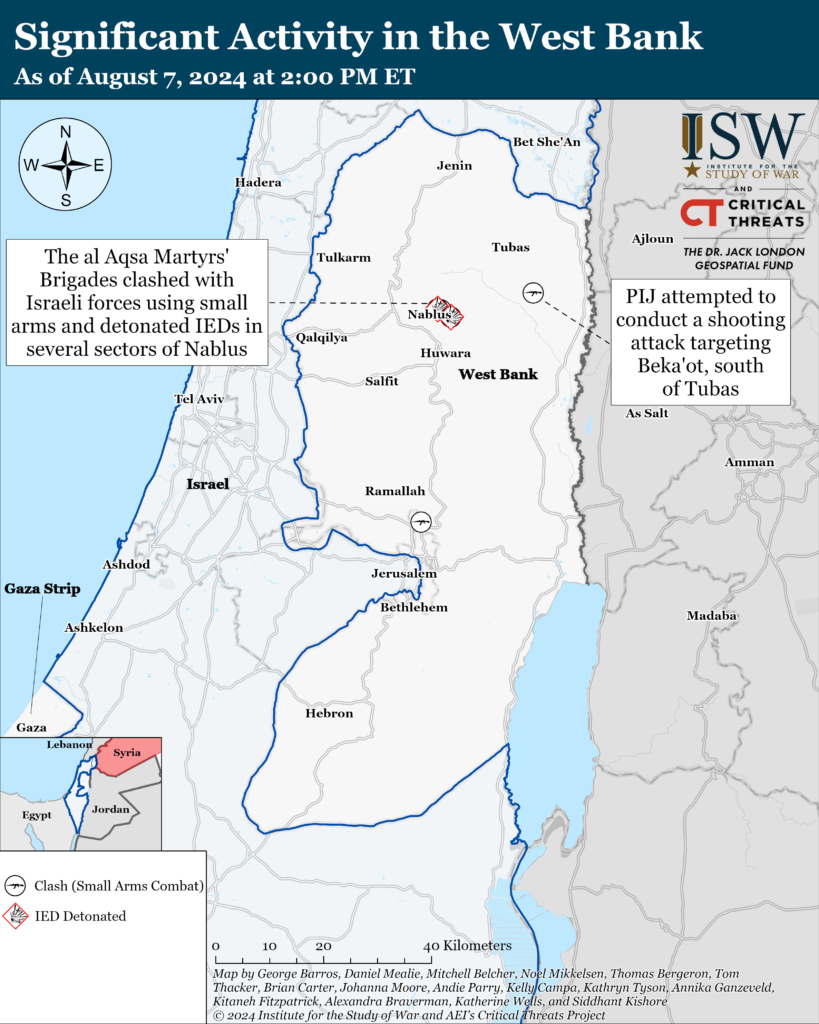
This map is not an exhaustive depiction of clashes and demonstrations in the West Bank.
Southern Lebanon and Golan Heights
Axis of Resistance objectives:
Deter Israel from conducting a ground operation into Lebanon
Prepare for an expanded and protracted conflict with Israel in the near term
Expel the United States from Syria
Lebanese Hezbollah conducted at least seven attacks into northern Israel since CTP-ISW’s last data cut-off on August 6.[lxxvi] Hezbollah conducted a drone attack targeting IDF artillery positions at Zaoura in the Golan Heights.[lxxvii] The IDF said it detected several suspected drones that struck in the northern Golan Heights.[lxxviii] Hezbollah also fired about 10 Katyusha rockets targeting Ein Zeitem base near Safed.[lxxix] The IDF said air defenses intercepted some rockets, and the remaining rockets fell in open areas.[lxxx]
The IDF Air Force struck and killed a Lebanese Hezbollah anti-tank unit commander in southern Lebanon, on August 7.[lxxxi] The IDF said it killed Hassan Fars Jashi in Jouiya, southern Lebanon.[lxxxii] The IDF said Jashi was responsible for Hezbollah’s anti-tank guided missile fire that targeted military sites in northern Israel.[lxxxiii] Hezbollah released a statement mourning Jashi on August 7.[lxxxiv]
Israeli Defense Minister Yoav Gallant said on August 7 that a Hezbollah attack on Israel could “deteriorate into a state of war” during a visit with the IDF 646th Brigade (Res.) in northern Israel. [lxxxv] Gallant said that “as things stand—Nasrallah may drag Lebanon into paying extremely heavy prices.“ Nasrallah gave a speech on August 6 affirming that Hezbollah, Iran and the Houthis would “respond“ to Israeli strikes that killed senior axis leaders and damaged infrastructure.[lxxxvi]
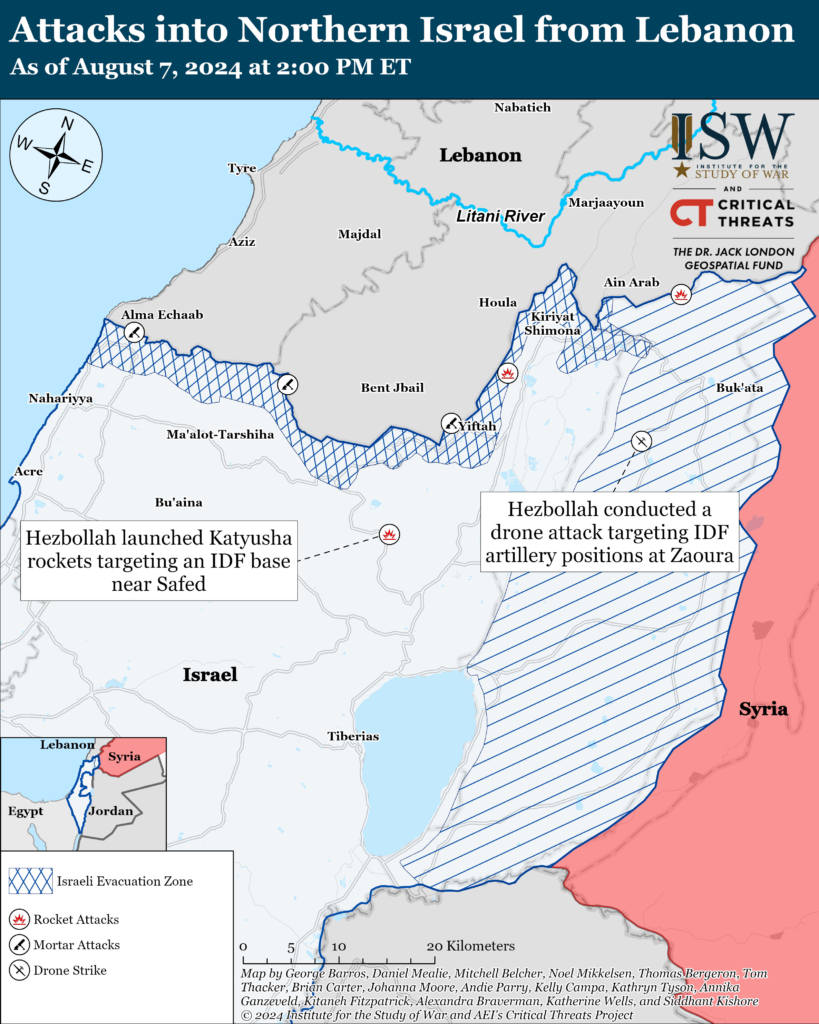
Iran and the Axis of Resistance
Iranian President Masoud Pezeshkian said that Iran remains committed to responding to Haniyeh’s death in a phone call with French President Emmanuel Macron on August 7.[lxxxvii] Pezeshkian dismissed Macron’s call for restraint and stated that “if the United States and the Western countries are truly seeking to prevent war in the region, they must force [Israel]” to accept a ceasefire in Gaza.”[lxxxviii] This is the second call between Pezeshkian and Macron since July 28. They also spoke on July 29 to discuss regional tensions.[lxxxix] Macron urged Iran to support de-escalation between Lebanon and Israel, halt its support for Russia’s war in Ukraine, and release French citizens held by Iran.
Interim Iranian Foreign Minister Ali Bagheri Kani asserted Iran’s “right to retaliate against Israel in a series of phone calls with several foreign ministers on August 7.[xc] Bagheri Kani asserted that the assassination of Haniyeh in Tehran was a violation of Iran’s sovereignty and national security and condemned Europe’s lack of action against Israel in a phone call with British Foreign Secretary David Lammy.[xci] Lammy urged Iran to practice restraint with its retaliation. Bagheri Kani also said that Iran will take “legitimate and decisive action” in his phone call with Syria Foreign Minister Faisal al Mekdad.[xcii] Mekdad emphasized Syria’s “all-round and stable support” for Iran. Bagheri Kani also discussed the consequences for Israel following Haniyeh’s death in a phone call with Egyptian Foreign Minister Badr Abdelatty.[xciii] Bagheri Kani declared that Iran would establish deterrence against Israel in retaliation for Haniyeh’s death in separate phone calls with the Maltese, Swiss, and Austrian foreign ministers.[xciv]
Iran has recently increased domestic repression as it prepares for its retaliatory strike against Israel. Iranian authorities unveiled a new strategy on August 4 to enforce mandatory hijab laws, according to reformist newspaper Shargh Daily.[xcv] The new strategy involves three unspecified phases including the deployment of 1,500 volunteer “missionaries” to promote the “culture of chastity and hijab” with a special focus on schools and education centers. The campaign will reportedly focus primarily on teenagers and will provide ”training courses” on hijab. Culture and Islamic Guidance Director General for Khorasan Razavi Province Mohammad Hosseinzadeh stated that the integration of this plan with the Tarah-e Noor, or Light Plan, has not been finalized yet. Iran unveiled its Light Plan, which similarly increased hijab enforcement, in April 2024. The Light Plan coincided with Iran’s April 13 retaliatory strike on Israel.[xcvi] Iranian authorities separately executed 29 men on August 7, according to international human rights organizations.[xcvii]
The Iranian Artesh Air Defense Force commander assessed the Eastern Air Defense Force’s readiness in South Khorasan on August 7. The Artesh equipped the Eastern Command in South Khorasan province with Iranian-made missiles, drones, and radar systems.[xcviii] Sabahi Fard assessed the Eastern Air Defense Force’s level of defense readiness and led the opening ceremony for the regional security operations center, the Jangal Center for Electronic Warfare, the Amad Support and Training Battalions as well as other new infrastructure projects in the air defense zone.
US Central Command (CENTCOM) intercepted a Houthi drone and two Houthi anti-ship ballistic missiles over the Red Sea on August 6.[xcix] CENTCOM determined that these Houthi systems presented a clear and imminent threat to US and coalition forces and merchant vessels in the region.
Houthi military spokesperson Yahya Sarea claimed that Houthis targeted two US destroyers and one merchant vessel in a speech on August 7.[c] The Houthis claimed that its fighters hit the USS Cole and the USS Laboon with an unspecified number of drones and ballistic missiles.[ci] The Houthis did not provide evidence for this assertion. Sarea stated that the Houthis launched “a number of missiles” at the Liberian-flagged Contship Ono merchant cargo ship set for Jeddah, Saudi Arabia.[cii] The Houthis claimed that the company that owns Contship Ono violated the Houthi’s ban against trade to Israel.
 Eurasia Press & News
Eurasia Press & News
